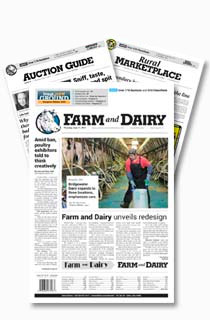Beginning in June 2023, farmers won’t be able to buy any over-the-counter antibiotics for their animals. This will be a big change for farmers, many of whom are accustomed to doing much of their own veterinary care. Like it or not, farmers need to be prepared.
“Change is hard for everyone, and this is a huge change for those commonly used drugs that every livestock producer and a lot of small animals folks are used to being able to purchase over the counter,” said Erika Alt, assistant state veterinarian for the West Virginia Department of Agriculture, during a March 22 West Virginia University Extension webinar explaining the Food and Drug Administration’s Guidance for Industry No. 263.
“Just like the veterinary feed directive, this too is going to take a little while for everyone to come to terms with it and what that change really means.”
The new FDA guidance recommends manufacturers of “medically important antimicrobials” that are currently available over-the-counter label their drugs available by prescription only. The guidance was finalized in June 2021 and will take effect in June 2023 nationwide.
How it will work
That means farmers will need to have a veterinary-client-patient relationship, or VCPR, in order to get antibiotics like penicillin, oxytetracycline and erythromycin.
How VCPR is defined varies slightly from state to state, but it basically means a veterinarian knows an animal and/or the operation well enough to diagnose and treat a medical condition, said Roselle Busch, a University of California sheep and goat veterinary medicine extension specialist, during the webinar.
The veterinarian has assumed responsibility to make medical judgments for a farmer’s animals, the veterinarian will communicate those judgments with the client, and the client agrees to follow the instructions of the vet, she said. The vet should also be available for follow-ups in case an adverse reaction occurs. Typically, this means a producer has regular visits with the veterinarian in the care of their animals.
“Routine visits might mean something different for different operation,” Busch said. “So, defining what that might look like for you with your veterinarian, every relationship’s going to be different.”
In West Virginia, the VCPR requires a veterinarian to visit a farm at least once a year, Alt said. They don’t need to see every animal on the farm, but enough to be able to make a medical judgment. That’s pretty typical of how VCPR’s work in other states as well.
The new guidance does not require farmers to purchase antibiotics through their veterinarian, Alt said. People can use online pharmacies as long as they have a prescription.
The guidance also does not affect anti-parasitic drugs, said Scott Bowdridge, associate professor of food animal production at West Virginia University. Though there is evidence of resistance in animals to certain anti-parasitics, the drugs used to treat parasites in animals are specific to agricultural species.
“So, not the same worms, but they could be the same bacteria that are in animals that can be in people,” he said.
Background
The guidance is part of an effort to combat antibiotic resistance, Busch said. An earlier guidance for industry recommended antibiotics administered in feed or drinking water be made prescription only. The change was implemented in January 2017. That type of antibiotic represented about 95% of the market, while the other 5%, mostly injectable antibiotics, stayed over-the-counter. Sales of the feed administered antibiotics dropped significantly after being made prescription-only, suggesting to the FDA that moving the products under veterinary oversight influenced judicious use.
Regulations around antibiotics began in Sweden in 1986 when all growth-promoting antibiotics in animal feed were banned. The European Union followed suit in the ’90s and early ’00s, banning antibiotic feed additives over concerns about antibiotic resistance in humans.
“Any time an antibiotic is used, regardless of the indication, there is potential for either adverse effects or development of antibiotic resistance,” Busch said. “Truly, any time we use an antibiotic, we could potentially promote the development of resistance, which is why we want to eliminate the use of antibiotics when they’re not needed.”
On top of that, using antibiotics is costly, “and no one wants to just throw money down the drain,” she said.
Examples
To see how it will work in the rest of the country, farmers can look to California, which made all medically important antibiotics available by prescription only starting in 2018.
Busch, a California vet and extension specialist, said California producers had the same concerns many farmers here have about impacts to animal health and operating costs, but they’ve adapted and many have realized the value of working with a veterinarian.
Busch said in some remote areas, veterinarians make an annual trip to a farm to establish or maintain that VCPR. Then follow-up consulting is often done over the phone. A veterinarian visit may still be needed for emergencies, but even some of those situations can be planned for ahead of time.
“Having those relationships in place before June 2023 can really help eliminate that concern that you can’t have antibiotics on your place when a pneumonia pops up, right? You know how quickly they go downhill,” Busch said. “So, if you’re lambing or kidding and you have a protocol for pneumonia, that’s something you can work out with your veterinarian for having those drugs on hand so you can treat the animal as soon as possible.”
Of course, none of this alleviates the shortage of large animal veterinarians in rural areas, but it gives farmers time to prepare.
“Don’t wait until you have an emergency or you really need some of those drugs on hand,” Alt said.
Further resources:
Full list of antibiotics affected by GFI 263
FDA’s GFI 263: Frequently Asked Questions for Farmers and Ranchers
Past Farm and Dairy coverage: FDA proposes animal antibiotics go behind the counter
(Reporter Rachel Wagoner can be contacted at 800-837-3419 or rachel@farmanddairy.com.)











what a load of BS this is just vets trying to get richer and take away our freedom to raise our own food. The food already cost to much for most people now
This is exactly what we need… More government oversight, or people that have no idea what they are talking about deciding how I should raise my animals. Forcing me to shell out more thousands to a veterinarian just to get simple medications is ridiculous. Can’t wait to hear about the ban of all OTC meds for humans too.
There are no large animal vets who will come to our farm, they are not taking new patients. We are in a very rural
area and have to handle our own emergencies. We recent lost a cow after she calved and we couldn’t get anyone to come and help. The fact we will have to rely on a vet we don’t have, for medication, just makes it harder.
Lovely, trying to find a vet who sees goats is almost impossible and if you do they are not taking on any new clients because they are overwhelmed. Let farmers alone the government in nevera help except for themselves
Exactly. I raise goats and getting a goat vet is like trying to turn water into gold. good luck is all you get.
Ignorant and a direct threat to the goat breeders. Long time goat breeders know far more about goats than vets who do not specialize in goats. FAR MORE.
What about the bird and fish antibiotics peppers buy wonder when this gets banned
Definitely part of the reason I’d say.
The only way this will stop in medicine (for our animals and us) is when the medical providers stop listening and being bought out. The good ones leave, see if you can find them, they don’t want to leave but they can’t “comply” with this garbage. You can figure out the rest of the plan from that. Stand up! Find your work around now, it will depend more on you than ever before. We can do this!
The reason this has happened is because some have the audacity to think they are more qualified than a vet. HINT:you aren’t. The typical farm store drugs have been overused to such an extent that they are next to worthless. Most producers haven’t a clue about the newer classes of drugs….it is a whole new world out there and it’s new because enough people had the attitude that they know better than the vet and abused the drugs to the point if rendering them ineffective for humans and animals.
No…Actually most vets don’t know as much as cattle ranchers do, on the big cattle ranches that operate in remote regions. In fact, some of the smarter vets come out to LEARN how it is done on big outfits. They never seen how a cowboy operates and learn a whole pile of things that are simply not taught in academia.
How do you manage to get a hat on that pointed, know it all head of yours? You are totally wrong and out of touch with reality!!
Well if anyone wants to see what DOESN’T work they can always look at California. This is stupid. I run a VERY small hobby farm but I know how to take care of my animals. I might break even if I’m lucky. If a vet bill pops up then I’m definitely in the hole. This is just yet another attack on self sufficiency and trying to raise your own food.
Common sense will tell you that its not acceptable to take a $3 duck to a $40 office visit for a $15 script.
I think the Big Ag lobbyists were very clever in getting this mess through. And we all know the resistance problem starts there, not with backyard farmers who shop at feed stores. Big Ag all have vets on staff, so there’s no impact at all for them.
You can buy a goat for 50$ at auction, is it worth spending 150$ for a vet visit? Imagine trying to be a profitable goat farm like that with several hundred…..
We need to reinvent agriculture on a smaller scale to take care of ourselves and our families. I sold off our dairy heard last year because it was getting just to hard to do the work 365 days a year. I can’t do it forever anyway! As the farms keep getting larger the only way forward is complete corporate takeover! Over my farming carrier my farm has grown into several 20’s and 40’s away from the main farm which will make it easier to get it to my children and grandchildren is smaller farms and so it doesn’t end up as part of a mega-farm!!!
This is horrible idea and of course to much Government overreach. Currently less than 3% of vet students go into large animal medicine practice. Why? well getting kicked by a 2800 pound cow is not exactly what they romanticized and tv told them would happen. Further more 6 figures in debt verses the income they can make are drastically different and in most cases are not worth their time. So how is this going to work if there is no vet in your area taking an $1800 plus dollar loss every time you loose a cow is going to put you out of business. Not to mention how is this going to affect the food supply? HMMM! well if only 2% feed 98% I imagine this is a way to cut out the small local farms and push harder for 15 min cities in their place and I am sure the cock roach burgers bill gates want us to go to are much better. Also how many of these vets are going to up and work on call 365 days a year? that’s why most go to the companion pet side. you can ready any live stock book and they wish you good luck on finding a vet that will even take new patients of live stock ( Cows, pigs, sheep, goats, horses etc.) So thanks big government for screwing up one more thing. In general if an animal gets sick and a vet can’t get to it its’ going to die without the farmers being able to treat quickly. further more if your animal is injured vet cant get to it in time slaughter house is backed up so we just going to let it lay their and suffer?
Well it’s actually just the antibiotics and ppl that just don’t know. That random giveing wrong meds which make animals resistant to them. And u can always stock up for a next time they will do that from all the stuff I have been hearing plus Vet only needs to know bout the animal n have on record to give script. It’s no different then the things the FDA has taken from the community in pain. Etc. Jesus I live in a real rural place and if u have the world’s worst pain if u are not in the hospital for a stay or dying of cancer u can’t get pain meds to save ur life. I don’t care who ya are. Even after a surgery nope sorry no pain meds for you!!!! It’s riduculos what this world is coming to these days. This free place ain’t so damn free no more is it!!! No amount of votes or complaints or other can change what the politicians are doing to this free world. They gave the FDA the reins and the DEA the others. Told the marijuana growers okay we let u smoke pot you give us ur pain meds n well. We r now classified as low or lower then our fur families… Period.
You comment is misinformed. So you gonna load up a 1500 lbd bull to take it to a routine doctor visit. I bet you don’t live out in the country like you claim at best you have no clue how we raise our animals. We as producers damm sure don’t want to give them meds but we do know when and what works for them after decades of raising animals. The honest truth is the Current administration was pissed folks went and got erythromycin and they are determined to never let that happen again
This is absurd, and now animals will be suffering at the hands of ignorant humans. There is no farm vet that local to where I live. You desk sitting degree holders should be ashamed of yourselves. I am one unhappy, small, hobby farmer. And what vets are within 40 minutes I have to take the animals to which costs an arm and a leg and doesn’t work with my husband’s schedule. Again you should be ashamed of yourselves.
This is typical of the FDA. They have no idea what they are doing they are just making laws and calling them regulations. Government over reach at its best.
Vets aren’t taking new patients and it’s almost impossible to get one to do a farm call anymore. They close before 5 through the week and most don’t even open on Saturdays any longer. Your regular vet isn’t interested in a personal relationship with you because when needed after hours you will be turned away and sent to the emergency vet. Just more money in their pocket while they hold farmers, ranchers and the hobbyist hostage without a care for the outcome!
agreed
It is all about money and has nothing what so ever to do with human health or any thing else for that matter. Instead of getting the medication when needed we will get to simply watch our animals die so some pencil pusher can feel like they have done something and veterinarians can make more money. Disappointed as in completely.
Good luck hobby farming or homesteading. I have treated my livestock for over 20 years. Any morons that say it’s because we over use the should probably eat a bullet. Not one of us want to give any drug to our food that we feed our family with. We all need to get together and take this to court. This isn’t American. Mor of a dictatorship.
As a small animal producer this is only going to get worse first this then what. You are not believing the BS they put out the real reason during the pandemic folks went out and bought erythromycin and well they could not let that happen again. You will obey
We need to organize and protest this it’s wrong
Animals are gonna die let me explain animal cost 50-75 dollars at auction goat,sheep,calves now vet costs me 300 dollars visit plus additional fee of 200-300 to drive out to my ranch plus a week lost to scheduling me. Ok so now 75 dollar animal costs me 600+ dollars so I have to sell 4animals to recoup my money or I just put down the sick animals and go buy more 30-60 day quarantine on them then release them into heard this…ok now lets look at other angle I do yearly tooth inspection of the beef cow heard pull a infected tooth and now a once easy treatment becomes fatal because of scheduling or unatainable because of cost and availability now my cats in my pond get velvet another easy cure gone so now I drain pond kill all life in the pond